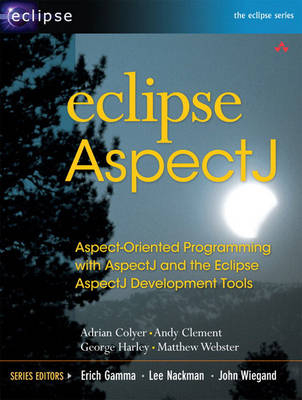
Eclipse AspectJ
Addison-Wesley Educational Publishers Inc (Verlag)
978-0-321-24587-8 (ISBN)
- Titel ist leider vergriffen;
keine Neuauflage - Artikel merken
About the Authors ADRIAN COLYER is a senior technical staff member at IBM, the leader of the AspectJ Eclipse project, and co-founder of the AspectJ Development Tools (AJDT) for Eclipse project. Currently he leads an IBM team developing and applying aspect-oriented technology. ANDY CLEMENT is a senior software developer at IBM's Laboratory at Hursley Park, a committer on the AspectJ project, and co-founder of the AJDT project. He is also involved in the use of aspects in J2EE middleware. GEORGE HARLEY is a senior developer at IBM's Hursley Laboratory currently working on AJDT and deploying aspect technology in enterprise applications. MATTHEW WEBSTER joined IBM in 1989 and is currently developing aspect-oriented technology for use with IBM products. © Copyright Pearson Education. All rights reserved.
Preface.
Introduction.
I. INTRODUCING ECLIPSE, ASPECTJ, AND AJDT.
1. Getting Started.
What Is Eclipse?
Installing Eclipse.
Eclipse Basics.
Installing AJDT.
Examples for This Book.
Summary .
2. First Steps in AJDT.
A Simple Insurance Application.
Tracking Policy Updates.
Creating an AspectJ Project.
Creating the PolicyChangeNotification Aspect.
Stating the Notification Policy.
Implementing the Notification Policy.
Showing Advice In AJDT.
Evaluating the Implementation.
Finishing Touches.
Summary.
3. Extending the Application.
The Story So Far.
Serialization-Based Persistence.
Hibernating.
Managing Build Configurations.
Summary.
4. More AJDT.
Building an ASPECTJ Project.
Debugging.
Editor Templates and the Outline View Toolbar.
Generating Documentation (Ajdoc).
AspectJ Help, Examples, and Cheat Sheets.
Summary.
II. THE ASPECTJ LANGUAGE.
5. An Overview of AspectJ.
What Is An Aspect?
Join Points and Pointcuts.
Advice.
Inter-Type Declarations.
Key Design Properties of the AspectJ Language.
Summary.
References.
6. Straight to the Point.
The Calculator Program.
Introduction to Pointcut Designators.
The Method Call Pointcut Designator.
Pointcut Composition.
Patterns and Signatures.
The Method Execution Pointcut Designator.
The Target Pointcut Designator.
The this Pointcut Designator.
The get and set Pointcut Designators.
Capturing Context with the args Pointcut Designator.
Extracting Values with this and target.
The handler Pointcut Designator.
Initialization Pointcut Designators.
Static Scoping Pointcut Designators: within, withincode.
Dynamic Scoping Pointcut Designators: cflow, cflowbelow.
The adviceexecution Pointcut Designator.
The if Pointcut Designator.
How to Write a Good Pointcut.
Common Pitfalls.
Summary.
7. Take My Advice.
The Different Types of Advice.
Advice Parameters and Pointcuts.
Writing Logic in the Body of Advice.
Advice Ordering.
Softening Exceptions.
declare warning and declare error.
Common Pitfalls.
Summary.
References.
8. Inter-Type Declarations.
Fields, Methods, and Constructors.
Scope and Visibility.
Inter-Type Declarations and Interfaces.
Extending Classes.
Using Pointcuts and Advice with Inter-Type Declarations.
Summary.
9. Aspects.
Aspect Definition and Initialization.
Aspect Instantiation.
Aspect Inheritance.
Inner Aspects.
Aspect Privilege.
Common Pitfalls.
Summary.
10. Using the AspectJ API.
Package org.aspectj.lang.
Package org.aspectj.lang.reflect.
Summary.
III. PUTTING IT ALL TOGETHER.
11. Adopting AspectJ.
The Adoption Process.
Different Types of Aspects.
Enforcement Aspect Examples.
Infrastructure Aspect Examples.
Core Aspect Examples.
Evaluating the Simple Insurance Application.
Summary.
References.
12. Advanced AJDT.
Aspect Libraries.
Linking Aspects with Compiled .class Files.
Ant Integration.
Aspect Visualization.
Summary.
13. Aspect-Oriented Design.
Finding Aspects.
What Makes a Good Aspect?
Closing Thoughts.
Appendix A. Command-Line AspectJ.
Installing AspectJ.
Using the Compiler.
Building with Ant.
Appendix B. AspectJ Language Quick Reference.
Aspect Declaration.
Pointcuts.
Wildcards.
Advice.
Inter-Type Declarations.
Appendix C. Next Steps.
Mailing Lists and FAQ.
Raising Bugs and Enhancement Requests.
Contributing to the Development of AspectJ and AJDT
Appendix D. AJDT Icons Reference.
Objects.
Object Adornments.
Markers.
Build Configuration.
Index.
| Erscheint lt. Verlag | 6.1.2005 |
|---|---|
| Reihe/Serie | the eclipse series |
| Verlagsort | New Jersey |
| Sprache | englisch |
| Maße | 180 x 239 mm |
| Gewicht | 738 g |
| Themenwelt | Informatik ► Programmiersprachen / -werkzeuge ► Eclipse |
| Informatik ► Programmiersprachen / -werkzeuge ► Java | |
| Mathematik / Informatik ► Informatik ► Web / Internet | |
| Schlagworte | AspectJ • Eclipse |
| ISBN-10 | 0-321-24587-3 / 0321245873 |
| ISBN-13 | 978-0-321-24587-8 / 9780321245878 |
| Zustand | Neuware |
| Haben Sie eine Frage zum Produkt? |
aus dem Bereich

